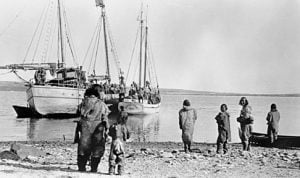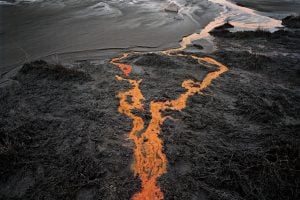
Exploration
The pull of Everest
A century after a Canadian was instrumental in charting the world's highest peak, a fellow Canadian reflects on the magnetism of Everest
- 4083 words
- 17 minutes
History
The Canadian Arctic explorer’s evocative series of watercolours brings to life the beauty he experienced during a doomed overland trek to the Polar Sea

A solitary white wolf floats across the hills surrounding Fort Enterprise. An omen among a smattering of caribou foraging on tripe-de-roche lichen. Hiding in the stands of spruce swirling across the snow-covered landscape. Howling as the aurora borealis splashes across the night sky.
Midshipman George Back records this sighting in his field book on October 18, 1820, as he and a small party set out on an 890-kilometre journey south to Fort Providence (Yałtı Nedhé Kuę́ to the Yellowknives Dene) for badly needed supplies: lead for ammunition, tobacco, blankets, cloth and iron. The crew of Captain John Franklin’s first overland expedition to chart the Arctic coast east of the Coppermine River was about to face a brutal winter at Fort Enterprise (Mǫlà Kǫ̀kʼe).

At only 23 years old, Back had already served in the British Royal Navy for 12 years.
While he was cutting his teeth on naval ships, a young Back was also honing his artistic skills. Ultimately, it was Back’s artistic talent that caught Franklin’s eye and landed him a spot on the veteran captain’s overland expedition.
Throughout most of the arduous journey, Back sketched and painted — as a midshipman, along with Robert Hood, he was charged with recording what he saw through detailed renderings, notes, measurements and maps. These last three duties seemed secondary for Back as he filled his field books with colour studies of northern sunsets and realistic depictions of Indigenous Peoples (without whom as guides, along with the voyageurs, the expedition would have barely made it out of the gate). He drew caribou, bison and beaver, pines and lichen. He drew in times of feast and in times of shoe-eating famine.
When Back finally returned to Fort Enterprise five months later with four supply-laden sledges, he found that the crew had narrowly made it through the winter. His supplies — particularly the ammunition — and the return of the caribou and waterfowl to the landscape replenished them ahead of their culminating trek to the Arctic Ocean.


The expedition reaches the mouth of the Coppermine in late July, and Back paints their triumph, awash in a rose-gold glow at midnight, the confluence of a near-black rocky shoreline of the ocean and a sage green tundra. On the left, a Union Jack flies, claiming it for Great Britain.
Two weeks later, while charting the foggy shores of Bathurst Inlet, another solitary white wolf. The north winds begin to blow, game becomes scarce, and the crew’s two large birchbark canoes become more fragile with each wave. They turn back to wait out the season at Fort Enterprise.
They reach the interior again in late August, and Back paints Wilberforce Falls on the Hood River. Tall tawny cliffs gouged by a narrow and rough waterway, beautiful and treacherous. It’s easy to see why their canoes didn’t make it past this point. Shortly after, they eat the last of their food.

Winter moves in swiftly in the Arctic, and by mid-September 1821, they’ve been marching through the snow for weeks, subsisting mostly on tripe-de-roche and singed pieces of moccasin. Back paints what is likely his last scene until November. “Tripe-de-roche in the Barrens” looks about as bleak as it sounds: a detailed greyscale of a sparse camp at the foot of a rock face, crewmembers scattered across the page trying to survive.
The rest of September and October, recorded in the journals of Back, Franklin, Hood and others, is dire. For a second time, Back sets out to find help. This time he hopes to find the revered Yellowknives Dene Chief Akaitcho to save his crewmates. Some members, including Franklin, make it to the empty fort and they now cling to their last threads of life. Nine of the 20-man crew to the coast have either gone missing, starved to death, been shot or, in at least one instance, been eaten. On November 7, Dene hunters arrive just in time; if they had been one day later, Fort Enterprise would have been silent as a grave.
Back returns home to England the following spring and writes in a letter of that fateful winter, “To tell the truth, things have taken place which must not be known.”
More than 200 years later, Back’s artwork serves as a time capsule of a place, offering glimpses of beauty amid duty, compassion through hardship and, perhaps, what could not be known.
Are you passionate about Canadian geography?
You can support Canadian Geographic in 3 ways:

This story is from the November/December 2023 Issue

Exploration
A century after a Canadian was instrumental in charting the world's highest peak, a fellow Canadian reflects on the magnetism of Everest

Exploration
A century after the start of the thrilling expedition that strengthened claims to Canadian sovereignty in the Arctic, the first Canadian Arctic Expedition remains a largely unknown part of the country’s history

People & Culture
A century after the Group of Seven became famous for an idealized vision of Canadian nature, contemporary artists are incorporating environmental activism into work that highlights Canada’s disappearing landscapes

History
This year's search is about much more than underwater archaeology. The Victoria Strait Expedition will contribute to northern science and communities.